| The world will little note, nor
long remember, what we say here, but it can never forget what they did
here.
President Abraham Lincoln
Gettysburg Address
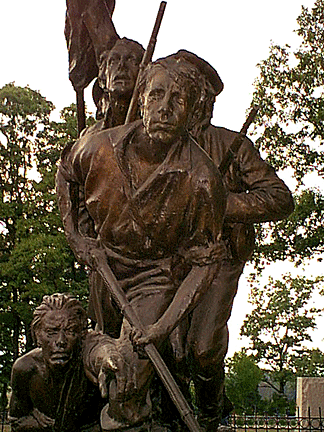 In the rolling hills of
south-central Pennsylvania lies the once sleepy town of Gettysburg.
Sleepy, that is, until one fateful day in July, 1863, when history
changed all that. From the moment the last skirmish ended, curiosity
seekers have made their way to the site of one of the most important
battles of the Civil War. Others, too, have come seeking to pay homage
to the dead, for it's to the thousands who died courageously here that
this battlefield is dedicated. In the rolling hills of
south-central Pennsylvania lies the once sleepy town of Gettysburg.
Sleepy, that is, until one fateful day in July, 1863, when history
changed all that. From the moment the last skirmish ended, curiosity
seekers have made their way to the site of one of the most important
battles of the Civil War. Others, too, have come seeking to pay homage
to the dead, for it's to the thousands who died courageously here that
this battlefield is dedicated.
Gettysburg has more monuments than any other battlefield—1,340 at last
count. The reason for this is quite simple. In the days following the
battle, those immediately touched by the death of fallen loved ones and
the nation needed a way to express their grief. Nothing as devastating
had happened to this young nation and monuments were a way of showing
honor. Also, the battle took place in the midst of the Victorian Age, a
time when death was a morbid fascination.
The average visitor to Gettysburg can't comprehend the awesome tragedy
that happened there. Today, the rolling fields are as calm as before the
battle, except for the hoards of tourists who flock there daily. It's
only by studying the heroic faces on the men sculpted in bronze that the
reason for the battle can be somewhat understood.
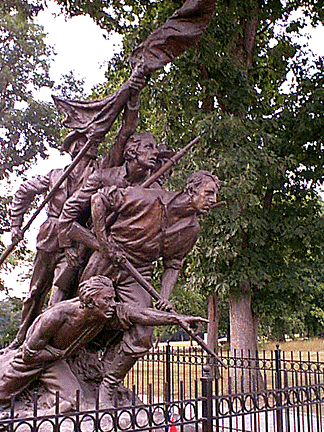 Despite their great numbers, their beauty, and their artistic and
symbolic variety, the Gettysburg memorials receive only casual
interpretation. Without much interpretation, visitors must rely on their
own knowledge of the memorials' significance and of the historical
contexts in which they were created. Despite their great numbers, their beauty, and their artistic and
symbolic variety, the Gettysburg memorials receive only casual
interpretation. Without much interpretation, visitors must rely on their
own knowledge of the memorials' significance and of the historical
contexts in which they were created.
An important feature of Gettysburg, the memorials represent an aspect of
history almost ignored—the commemorative development of historic
landscapes over time. Generation after generation has immortalized this
battlefield. In fact, the latest monument to those who fought from the
state of Maryland, will be dedicated this November.
Representing a long commemorative aftermath that has added richness and
variety to the battlefield's history and appearance, the memorials,
themselves, are historical phenomena worthy of more than a passing
glance.
Why were more monuments erected at Gettysburg than anywhere else? To
begin with, not only was the Civil War the most traumatic conflict this
nation has endured, it also occurred during the Victorian era, a time of
extensive monumentation. During this time, memorials were a popular
extension of public sentiment.
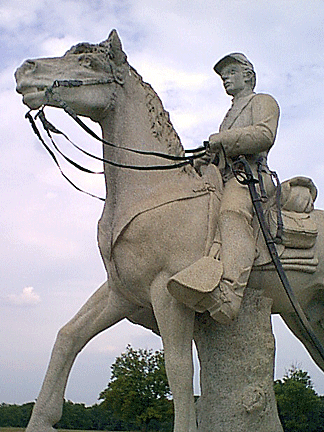 Also, widely reproduced photographs of the Civil War and, later, of the
newly erected monuments further instilled in the public's mind the idea
of memorialization. Thus, the Civil War battlefields of the 1860s, like
Gettysburg, became natural outlets for an outpouring of sentiment
expressed in granite, marble, and bronze. Also, widely reproduced photographs of the Civil War and, later, of the
newly erected monuments further instilled in the public's mind the idea
of memorialization. Thus, the Civil War battlefields of the 1860s, like
Gettysburg, became natural outlets for an outpouring of sentiment
expressed in granite, marble, and bronze.
In addition, by the last decade of the 19th century, governments at
every level--federal, state, and local--had become well established.
Great corporate and individual wealth existed as well. A catastrophic
war had concluded and people were able to afford to commemorate it.
Veteran's groups and other patriotic organizations encouraged the
building of these memorials. Except for Grover Cleveland, every
president from Ulysses S. Grant through William McKinley was a member of
the Grand Army of the Republic (G.A.R.), as were many congressmen. The
efforts of these groups culminated in the establishment of Gettysburg
and other Civil War battlefields as national military parks. In
addition, the new law called for memorialization, which had, by this
time, already begun.
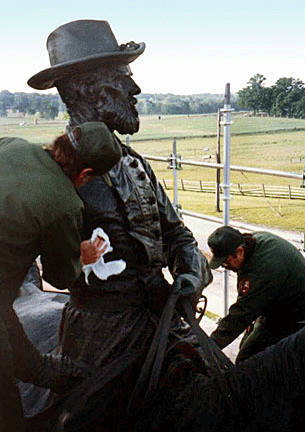 Preserving the land that a battle was fought on alone doesn't present a
specific perspective of that battle. Memorials, on the other hand,
interpret a battle by highlighting certain parts of the conflict to be
remembered. Marking the location of important encounters and recalling
acts by individuals, regiments, and entire armies, the memorials embody
memory and legend. Preserving the land that a battle was fought on alone doesn't present a
specific perspective of that battle. Memorials, on the other hand,
interpret a battle by highlighting certain parts of the conflict to be
remembered. Marking the location of important encounters and recalling
acts by individuals, regiments, and entire armies, the memorials embody
memory and legend.
Noted for their elegant bronze and stone sculpture, and for their unique
and varied designs, the Gettysburg memorials are more valuable, perhaps,
for the information they offer about the soldiers and their positions,
actions and casualties--information based on the soldiers' own personal
experiences.
In all, there are ten different types of monuments at Gettysburg. By
1912, the United States War Department had placed more than 350 tablets
and markers to explain the roles of specific military units. These
included: headquarters markers, distinguished by cannon tubes pointed
skyward; battery tablets, describing the actions of artillery batteries
(Union batteries had six guns, Confederate batteries four);
Confederate brigade markers, with round bases, describing the positions
of Confederate Brigades, each containing 1,600 men; and Union brigade
markers, with square bases, describing the positions of Union Brigades,
each containing 1,500 men.
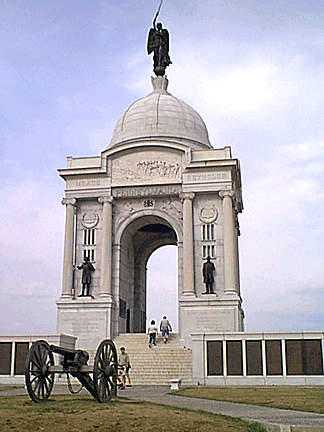 Some state memorials were erected soon after the battle. These
commemorate all the soldiers from a particular state. Ten Confederate
and five Union states are represented. The two most dramatic are the
Pennsylvania Memorial, the largest containing the names of more than
34,250 soldiers who defended their native soil, and the Virginia
Memorial, the most sculptural. the North Carolina Monument features the
sculpture of Gutson Borglum, the artist who carved Mount Rushmore. In
addition, generals and other notable persons are commemorated with
bronze statues. Some state memorials were erected soon after the battle. These
commemorate all the soldiers from a particular state. Ten Confederate
and five Union states are represented. The two most dramatic are the
Pennsylvania Memorial, the largest containing the names of more than
34,250 soldiers who defended their native soil, and the Virginia
Memorial, the most sculptural. the North Carolina Monument features the
sculpture of Gutson Borglum, the artist who carved Mount Rushmore. In
addition, generals and other notable persons are commemorated with
bronze statues.
Regimental monuments, the most numerous on the battlefield, commemorate
state militia and U.S. Regular Army regiments of 300-400 men. Erected by
veteran volunteers and the various state legislatures, these are
normally placed at the center of regiment's line of battle. The states
of Pennsylvania and New York placed the most regimental monuments with
123 and 108 respectively. Unfortunately, there
are few from the Confederacy. To the left and right of regimental
markers are flank markets marking the regiment's flanks, or ends.
Four state infantry divisions—the 23rd and 96th Pennsylvania, the 93rd
New York, and the 1st Maryland—all have monuments commemorating their
dead comrades.
Today, visitors to Gettysburg are seeing something of a miracle, even if
they don't realize it. Just as the wounds of the Civil War have been
healed, so have the ravages of time and weather on many of the monuments
to the fallen. An ambitious, on-going restoration and preservation
program at the Battlefield has successfully restored many of the
monuments. Two of the most dramatic restorations are those of the
Pennsylvania and Virginia State Monuments. Both were done on site using
a unique method of walnut-shell blasting to remove corrosion.
Afterwards, the original color, often found in protected areas, is
brought back to the bronze. Each was given a coat of a corrosion protectant
and waxed. Some monuments have been left their corrosive green color,
though fully protected from further corrosion.
As Abraham Lincoln so eloquently said, "the world can never forget what
they [the soldiers] did here," as long as the monuments erected in their
honor remain.
< Back to
History Articles
Go to next History article > |
